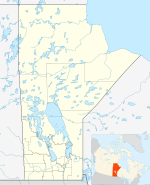Rural Municipality of St. François Xavier
Rural Municipality of St. François Xavier | |
|---|---|
 The statue of the White Horse describing the legend and the meaning behind the name White Horse Plains. | |
Location of St. François Xavier in Manitoba | |
| Coordinates: 49°59′25″N 97°40′20″W / 49.99028°N 97.67222°W | |
| Country | Canada |
| Province | Manitoba |
| Region | Central Plains |
| Area | |
• City | 204.56 km2 (78.98 sq mi) |
| • Metro | 5,306.79 km2 (2,048.96 sq mi) |
| Elevation | 242 m (794 ft) |
| Population | |
• City | 1,411 |
| • Density | 6.9/km2 (18/sq mi) |
| • Metro | 778,489 |
| Time zone | UTC-6 (CST) |
| • Summer (DST) | UTC-5 (CDT) |
St. François Xavier is a rural municipality lying west-northwest of Winnipeg, Manitoba, Canada. It is part of the Central Plains Region while also being part of the Winnipeg Metro Region. It had a population of 1,411 in the 2016 census.
History
The area around St. François was inhabited by first nations people such as the Cree and Sioux. The common name often used for the area, White Horse Plain arises from a local legend. Around 1824, Metis leader Cuthbert Grant received a land grant of land on White Horse Plain and founded a settlement. He was soon joined by a number of Métis families. The settlement was originally called "Grantown".[2]
In 1828, the parish of St. François Xavier, was established at White Horse Plain as the second parish in the North West, by priests from the mission at Saint-Boniface. The settlement then took its name from the parish. St. François Xavier became a municipality in 1880.
The present St. Francois Xavier Roman Catholic Church was designed by former St. Francois Xavier, architect Joseph-Azarie Senecal
Also, the Grey Nuns are woven into the fabric of the areas history. They had an educational and religious presence there for 118 years, ending their involvement in 1968.
The focal point for the RM was the community of St. François Xavier which was established in 1824 by Reverend Father Boucher.
See also
References
- ^ "Population data for Hanover". Statistics Canada. Retrieved February 20, 2017.
- ^ Morton, William. "Memorable Manitobans: Cuthbert James Grant (1793-1854)", Manitoba Historical Society
- R.M. of St. Francois Xavier Community Profile
- Community Profile: St. François Xavier Rural Municipality, Manitoba; Statistics Canada
External links


